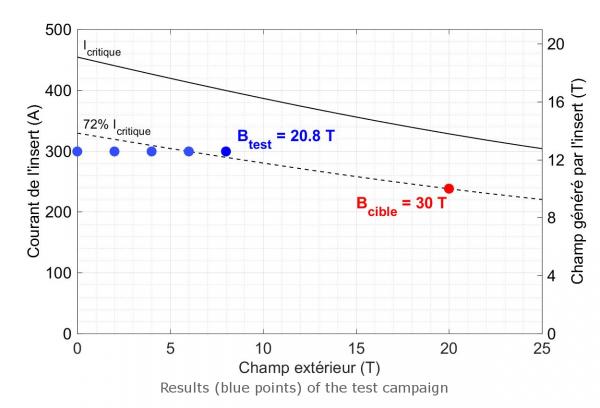The first test campaign of the NOUGAT high field magnet was successfully carried out at the CNRS LNCMI Grenoble. This laboratory wishes to build a 30-tesla magnet by assembling a resistive magnet from LNCMI and a superconducting magnet designed by IRFU based on high temperature superconducting materials. To date, the field reached 20.8 T, including 12.8 T generated by the superconducting magnet alone. This is a decisive step towards NOUGAT's 30 T operating point and the validation of MI (Metal-as-Insulation) winding technology, where traditional insulation is replaced by metal co-insulation, developed in the DACM's Superconducting Magnet (LEAS) Laboratory.
The DACM is involved in several high-field magnet projects including medical (MRI) and large test stations (such as the hybrid magnet LNCMI at 43T). To obtain high field values, it is necessary to use new generation high temperature superconductors (HTS) instead of NbTi or Nb3Sn. The department's HTS R&D is studying ways of producing such magnets and solving the problems inherent in these conductors at these high field values (thesis by G. Dilasser[1], thesis by M. ALHarake[2], internal R&D for non-insulated windings...).
1] Experimental and numerical study of shielding currents in REBCO high temperature superconducting magnets, thesis defended in 2017, G. Dilasser
2] Contribution to the study of a high field magnet 30-40 T, thesis in progress, Dr. ALHArake
As part of this R&D, the NOUGAT high temperature superconducting magnet has been studied, manufactured and tested. The NOUGAT experiment, consisting of the superconducting magnet (called insert) and resistive magnets, operated at up to 20.8 T in a stable manner for 45 minutes. The insert generated 12.8 T in an 8 T bottom field provided by ‘bitter’ resistive coils at LNCMI Grenoble (dark blue dot in Figure 2).
This insert is composed of 9 double-pads (figure 1) with an internal diameter of 50 mm using the "Metal-as-Insulation" (MI) winding consisting in replacing the traditional insulation by a metallic co-winding (see dedicated page here); it is thus possible to eliminate the complex protection system because the winding reacts autonomously to a quench thanks to the bypassing of the resistive zone by the current.
This is a first decisive step towards its operating point at 30 T (10 T generated by the insert in 20 T external, red dot on figure 2). Indeed, the operating point during this first test campaign is slightly higher than that required for 30 T operation (72% on the load line). Final tests will be carried out up to this value in spring 2019 when the new LNCMI Grenoble test station will be available.
This insert was made possible at the DACM thanks to ANR funding from 3 partners, the CEA, the CNRS-LNCMI and the Néel Institute.
Contacts : Philippe Fazilleau, Thibault Lécrevisse
• superconducting magnet physics and technology › Instrumentation and development for R&D magnets
• Accelerators, Cryogenics and Magnetism Division (DACM)
• LEAS





